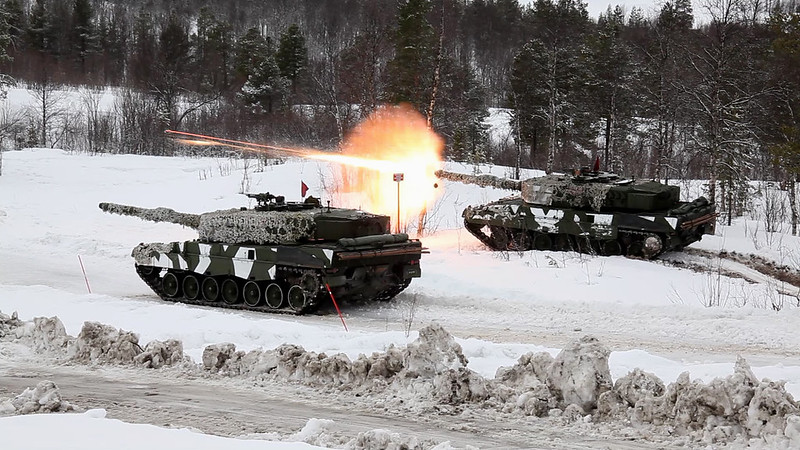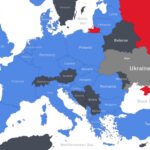
Norwegian tanks take part in a live-fire capabilities demonstration during Cold Response 14 in Norway March 14, 2014. Cold Response is a Norwegian-led exercise to rehearse high-intensity operations in winter conditions. Participants are from 15 NATO nations with the largest group of participants coming from the United States, Canada, France, the Netherlands, Great Britain and Sweden. (DoD photo by Tech. Sgt. Burt Traynor, U.S. Air Force/Released)
Whether or not you agree with American intervention in the war between Ukraine and Russia, one thing that is certain today is that Russia is no superpower, and the Europeans should be able to handle this themselves without U.S. involvement. The European continent is comprised of many of the wealthiest nations on earth. Their refusal to fund their own defense is not driven by a lack of funds but by the gullibility of American foreign policymakers who subsidize Europeans’ month-long vacations by taxing Americans to pay for defense equipment and personnel to protect the continent. Rajan Menon and Daniel R. DePetris explain in Foreign Policy that Europe doesn’t need the United States anymore. They write:
Consider some of the standard metrics used to compare countries’ military potential: GDP, population, defense spending, and level of technological advancement. They all show that Russia is far weaker than the 27-member European Union and that the balance of potential power indisputably favors Europe. At no point since the end of the Cold War has Russia’s economy amounted to more than 15 percent of Europe’s GDP—in 2021, Russia’s $1.8 trillion GDP was a fraction of the European Union’s $17 trillion.
When it comes to technology, Russia ranks 44th on the list of the world’s most technologically advanced countries, and as tech-savvy Russians leave the country to escape the military draft, it wouldn’t be surprising if its ranking has dropped further. Russia has one-third the population of the EU—and within that population, a sizable chunk of the working-age Russian men who haven’t fled are being conscripted and killed at the front. In January, Gen. Mark Milley, the chairman of the U.S. Joint Chiefs of Staff, stated that Russia’s killed or wounded totaled “significantly over 100,000,” while Norway’s chief of defense, Eirik Kristoffersen, estimated that the count had neared 180,000.
To be fair, one can’t fault U.S. officials for worrying about the threat to Europe once Putin’s war began. On paper, the Russian military looked like a large, competent force that could overrun Kyiv in days, and prominent commentators as well as the CIA predicted it would do just that. By some estimates, the Russian military spent at least $150 billion a year between 2014 and 2019 trying to refit, rebuild, and modernize its military and much more if one starts the tabulation from 2008, the year modernization efforts began.
For these reasons, once Russian troops crossed into Ukraine, the Biden administration vowed to defend every inch of NATO territory and deployed an additional 20,000 U.S. troops to Europe, bringing the total to around 100,000. More F-35 fighter jets were stationed in the United Kingdom, air defense systems were sent to Italy, and U.S. bases in Poland became permanent—the first such move on the alliance’s eastern flank.
Yet Russian military power is becoming depleted after nearly a year of fighting a tenacious Ukraine, which has inflicted heavy equipment losses and casualties on Putin’s forces. Helped by more than $27 billion in military assistance from the United States, the largest security contributor to Ukraine by far, as well as billions of dollars more from the U.K. and Europe, Ukraine has inflicted more losses on Russian forces in 11 months than the Soviet Army suffered during its nearly decade-long war in Afghanistan. (Most of this military aid has come from Britain and the United States, though European countries have stepped up their commitments recently.)
Russian equipment losses have been staggering: More than 1,600 tanks, 1,900 infantry fighting vehicles, and 290 armored personnel carriers have been destroyed, damaged, captured, or lost. Those losses will increase substantially now that Germany, after persistent pressure from the United States and several of its European allies, approved the transfer of an initial batch of 14 Leopard 2 tanks to Ukraine. Berlin’s decision paves the way for other countries such as Poland, Finland, Norway, the Netherlands, or Spain to send the Ukrainians some of their own Leopards, which are far superior to Russia’s T-90 or T-14 Armata models. (The latter, problem-ridden, has not even been deployed to battlefields in Ukraine.)
Russian forces that are dug into defensive positions in the east and south will soon face Ukrainian forces that have a substantially greater strength in mobile armored warfare, given the Leopard’s capabilities, which include thermal imaging and precision targeting. The Leopard, which comes in different versions and of which there are more than 2,000 in service across Europe, provides just one example of Europe’s advanced defense industry, which could, backed by political will, become much larger.
Given Europe’s massive advantage in resources, there is no reason why it cannot organize an effective defense against Russia. What, then, is stopping Europe from doing so?
If you’re willing to fight for Main Street America, click here to sign up for my free weekly email.





